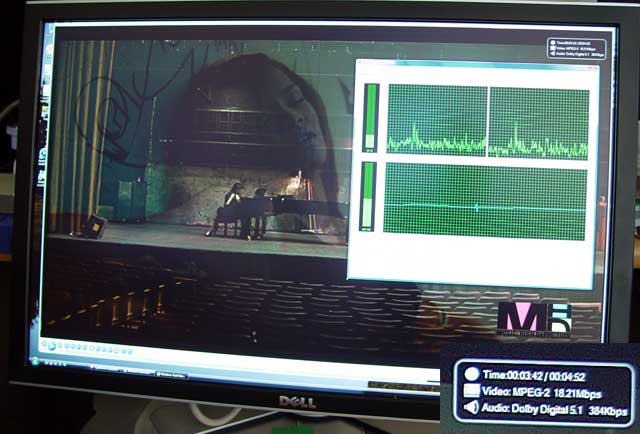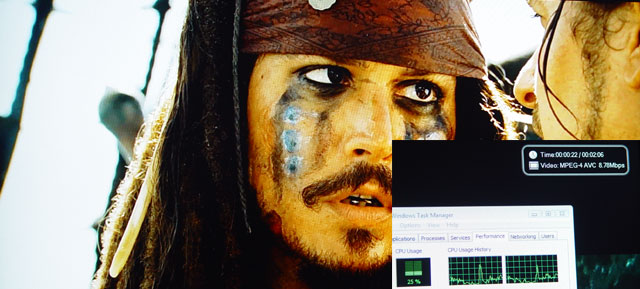Page 11 - Avivo HD #2
So how does this relate to the series HD 2000 Radeon graphics cards? In more ways than you think, just look at the latest trend of HTPC's, Home Theater PC's. Things like Media Center PC's. It's exactly these kind of things I am talking about. This is the future of media playback and the PC is going to play a very important role in that.
So what are the key advantages of Avivo HD technology? In my opinion two key factors are a big advantage. To offload the CPU by allowing the GPU to take over a huge sum of the workload. HDTV decoding through a TS (Transport Stream) file, for example, can be very demanding for a CPU. These media files can peak to 20 Mbit/sec easily as HDTV streams offer high-resolution playback in 1280x720p or even 1920x1080p without framedrops and image quality loss. In fact the cards can actually enhance image quality.
By offloading that big task for the bigger part of the graphics core, you give the CPU way more headroom to do other things, which actually makes your PC run normal. The combination of these factors offer you stutter-free high quality and high resolution media playback. All standard HDTV resolutions are of course supported, among them the obvious 480p, 720p and 1080i modes and now also 1080p (P=Progressive and I=Interlaced).
The new HD 2000 series will also offer HD noise reduction, which is a great feature with older converted films. And this is where we land at Image Quality. Avivo HD can offer a large amount of options that'll increase the IQ of playback. This can be managed with a wide variety of options. Obviously AMD has some interesting filters available in the Avivo HD suite like advanced de-interlacing, which can greatly improve image quality while playing back that DVD, MPEG2 or TS file (just some examples). Aside from that, things like colour corrections should not be forgotten. All major media streams are supported by AMD with Avivo HD. And yes, High Definition H.264 acceleration, which will become a big, new and preferred standard, is also supported.
AMD is prepared to take on NVIDIAs PureVideo HD with its next-generation AVIVO video processing. AVIVO is receiving its first upgrade since its introduction with the Radeon X1k-series with the RV610 and RV630. This time around, AMD is integrating its Universal Video Decoder, or UVD, for hardware decoding of H.264 and VC-1 high-definition video formats.
To give you an idea how intensely big one frame of 1920x1080 is with a framerate of 24 frames per second. Click on a the two example images above. Load them up, and realize that your graphics card is displaying that kind of content 24 times per second, while enhancing them in real-time.
update - 23rd May 2007
Please understand that the entire AMD ATI Radeon HD 2000-family features the latest Avivo HD technology yet only the 2400 and 2600 series actually have the UVD core logic.
AMDs upgraded Avivo with a new Universal Video Decoder, also known as UVD, and the new Advanced Video Processor, or AVP. UVD actually made its debut in the OEM-exclusive RV550 GPU core. UVD provides hardware acceleration of H.264 and VC-1 high definition video formats used by Blu-ray and HD DVD. The AVP allows the GPU to apply hardware acceleration and video processing functions while keeping power consumption low. It also means top notch decoding with an 128 point in HQV
AMDs UVD expands on the previous generations AVIVO implementation to include hardware bit stream processing and entropy decode functions. Hardware acceleration of frequency transform, pixel prediction and deblocking functions remain supported, as with the first generation AVIVO processing. AMDs Advanced Video Processor, or AVP, has also made the cut for low power video processing.

Lousy photos, sorry about that, but of course we gave it a try. We loaded up the all new PowerDVD and started up some High-definition content. Now you are looking at a 15-20 MBit/sec HD MPEG-2 HD broadcast bitstream.

Here we are decoding Pirates of the Caribbean - Dead Man's Chest - This is a 1080p MP4 / AVC. This is a H.264 endcoded file; while it has a much lower bitrate, the decoding process on the GPU is 4x more stringent. Resonably good results at rougly 25-30% CPU load; it's very hard to determine right now what is handled by the HD 2900 XT and what not as the HD 2900 does not have proper UVD support; it'll be paried with HD video capable CPU's.
As we found out the drivers used in this test don't yet have decode acceleration enabled either, first revision of that comes with 8.38
So for the 2400 & 2600 series goes that the entire process of Bitstream processing, Frequency transform, Pixel prediction towards deblocking up-to post-processing (up/downscaling / deinterlacing, color correction) and displaying is managed by Avivo HD on the 2400/2600 graphics cards, and that's including Blu-ray content with a 40MBit/sec bit-rate.
For the Radeon HD 2900 XT it'll be a symbiosis of the CPU and GPU post-processing wise, a little disspointing but the near future will tell how good that combo really is.
With upcoming driver releases we'll investigate furhter to see how well the HD 2900 working with Avivo (HD).


